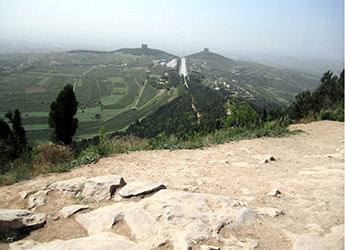It is overland tour to Mt. Wudangshan in Hubei province from Xian. Hubei province is located in mid China connecting many provinces in China by convenient transportation of railway, cruise, and flights......

 In the 7th century A.D., whilst Europe was still living in the Dark Ages after the fall of the Roman Empire, China was entering its golden age under the Tang Dynasty (A.D. 618-907). This dynasty produced 20 emperors, 18 of whom were buried in mausoleums scattered across the Guanzhong plain, China’s ‘Valley of the Kings’. One of these mausoleums is the Qianling Mausoleum.
In the 7th century A.D., whilst Europe was still living in the Dark Ages after the fall of the Roman Empire, China was entering its golden age under the Tang Dynasty (A.D. 618-907). This dynasty produced 20 emperors, 18 of whom were buried in mausoleums scattered across the Guanzhong plain, China’s ‘Valley of the Kings’. One of these mausoleums is the Qianling Mausoleum. One of the issues surrounding the Qianling Mausoleum is whether the tombs should be excavated or not. Although five tombs in the Qianling Mausoleum complex have been excavated, the rest are still untouched. One of the arguments put forward in support of re-starting archaeological excavations at the site is the fact that the Qianling Mausoleum is the only Tang Dynasty mausoleum that has not been plundered. It seems that the other 17 mausoleums were either plundered during the late Tang period, or the succeeding Five Dynasties period. Moreover, the richness found in the five attendant tombs has raised the hopes that the more important tombs would yield even greater treasures. Thus, it has been argued that the skeletal remains, precious grave goods, ceramics and carpentry inside the tombs would be able to help archaeologists gain a much better understanding of that period and imperial mortuary practices. Furthermore, it has been argued that the excavation would be considered as a form of salvage archaeology, as the area is prone to earthquakes. This claim, however, is not backed up by geological data.
One of the issues surrounding the Qianling Mausoleum is whether the tombs should be excavated or not. Although five tombs in the Qianling Mausoleum complex have been excavated, the rest are still untouched. One of the arguments put forward in support of re-starting archaeological excavations at the site is the fact that the Qianling Mausoleum is the only Tang Dynasty mausoleum that has not been plundered. It seems that the other 17 mausoleums were either plundered during the late Tang period, or the succeeding Five Dynasties period. Moreover, the richness found in the five attendant tombs has raised the hopes that the more important tombs would yield even greater treasures. Thus, it has been argued that the skeletal remains, precious grave goods, ceramics and carpentry inside the tombs would be able to help archaeologists gain a much better understanding of that period and imperial mortuary practices. Furthermore, it has been argued that the excavation would be considered as a form of salvage archaeology, as the area is prone to earthquakes. This claim, however, is not backed up by geological data.
It is overland tour to Mt. Wudangshan in Hubei province from Xian. Hubei province is located in mid China connecting many provinces in China by convenient transportation of railway, cruise, and flights......

One day classic tours of Chengdu to Mt. Qingchengshan and Dujiangyan Dam will show tourist the profound of ancient Chinese wisdom and culture in harmony relation with the world. ......

The most classic one day Chengdu tours will bring tourist to Chengdu Giant panda garden and Leshan giant buddha with private travel guide and car in Chengdu, extremely convenient and easy!......

One days best Chengdu tours bring tourist to Sanxingdui museum and giant panda garden with private guide and car, making your tour in Chengdu easy. ......
This panda volunteer work provide tourist with one days unique experience of Panda volunteer project works and bring them an intimate touch with Giant pandas, also the best way to learn deep about pand......

It is tour from the only one operator in Chengdu tours market offering Emeishan and Leshan tours by bullet train. Our highlights including Leshan Giant Buddha and Mt Emeishan. ......

